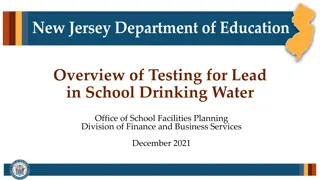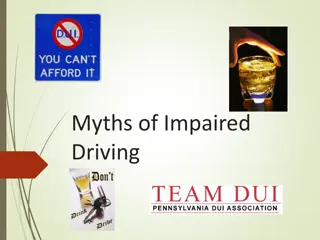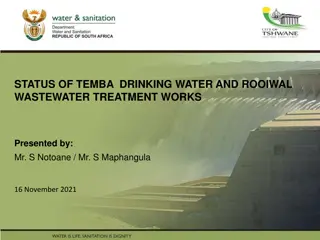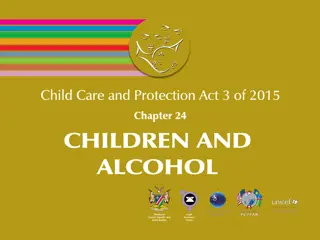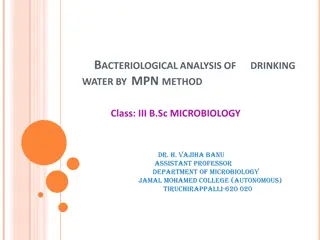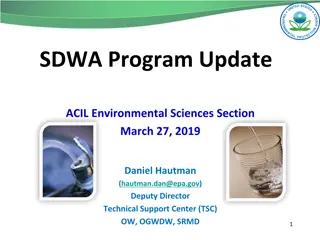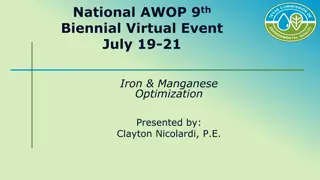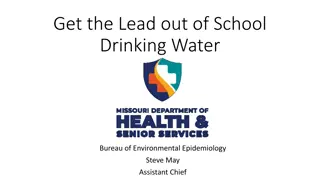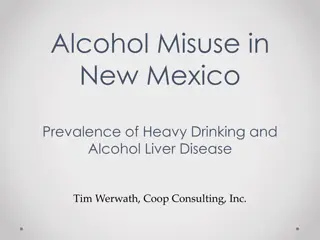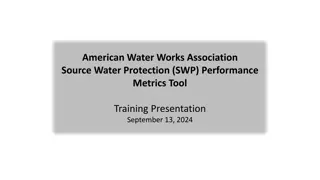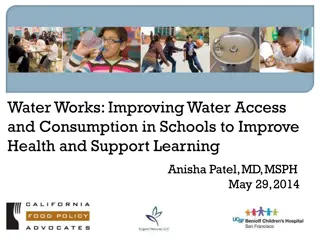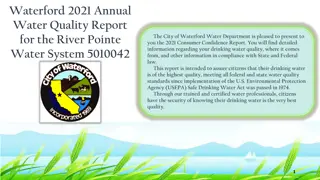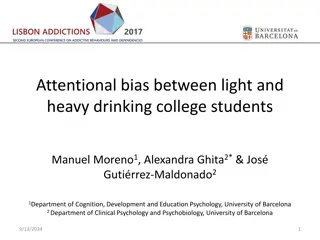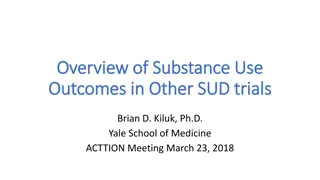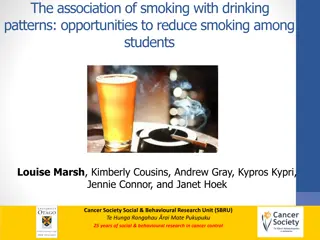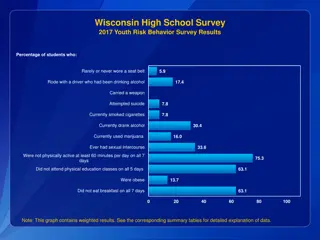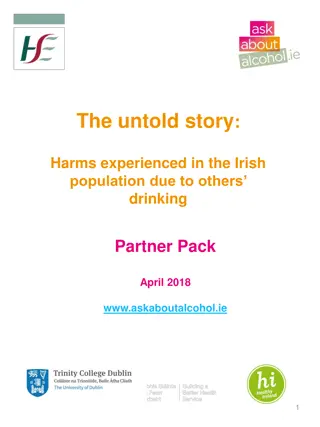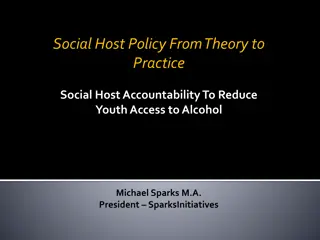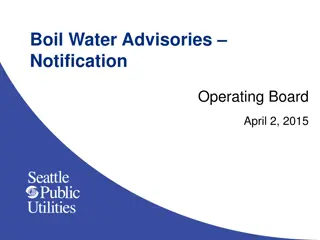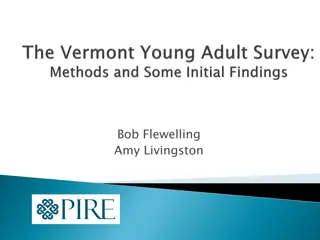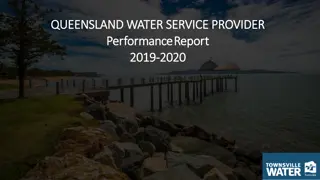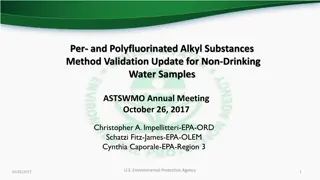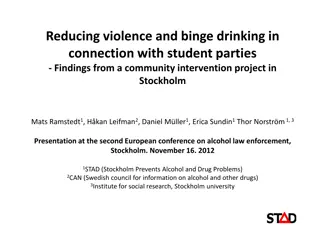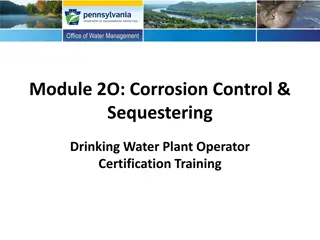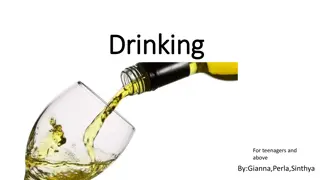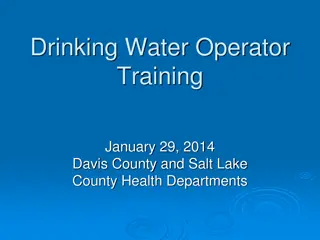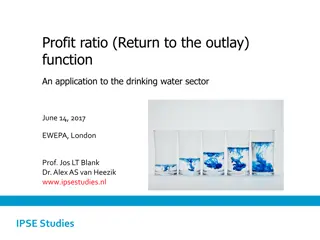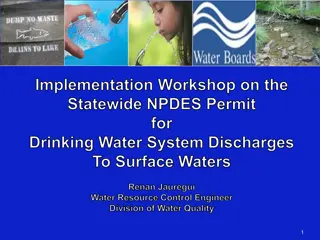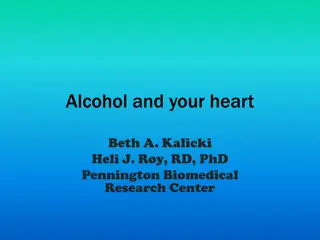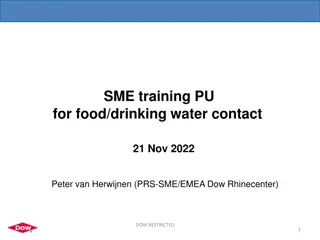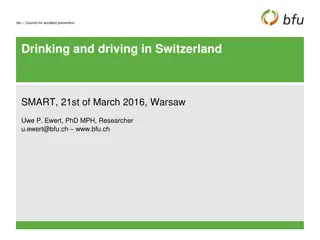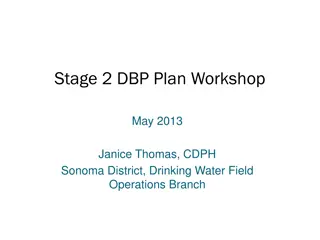Exploring Water Workshops and Drinking Water Sources
Discover the significance of water workshops, different drinking water sources like surface water and groundwater, the concept of watersheds, and the importance of water quality worldwide. Learn about challenges related to water health and innovative solutions for a sustainable future.
11 views • 52 slides
Managing Fluoride Levels in Drinking Water
Defluoridation is the process of adjusting fluoride levels in drinking water to the optimal range to prevent health issues such as fluorosis. The recommended fluoride level in drinking water is 1 ppm according to WHO guidelines. Various techniques like locating alternative water sources, defluoridat
0 views • 45 slides
Ensuring Safe Drinking Water in New Jersey Schools
Highlighting the importance of testing for lead in school drinking water, this overview covers NJDOE regulations, sources of lead contamination, federal drinking water regulations, and NJDOE requirements for testing. Lead exposure poses serious health risks, especially to children and pregnant women
0 views • 17 slides
Debunking Myths of Impaired Driving
Much of what we believe about drinking and alcohol are based on myths and misconceptions. This content presents common myths such as the alcohol content in beer compared to hard liquor, the misconception about daily drinking among alcoholics, the ineffective use of coffee to sober up a drunk person,
1 views • 40 slides
Challenges in Temba Drinking Water and Rooiwal Wastewater Treatment Works
The City of Tshwane's Water Services Authority faces significant challenges with the operation and quality of effluent at the Rooiwal Wastewater Treatment Works and the Temba Water Treatment Works. Issues include overcapacity, poor sludge management, non-compliant effluent, and inability to treat wa
0 views • 33 slides
Addressing Underage Drinking in Namibia: Child Care and Protection Act Amendments
The Child Care and Protection Act in Namibia has been amended to address the significant issue of underage drinking. The amendments include strengthening penalties for fake IDs, requiring ID checks by alcohol sellers, prohibiting under-18s from certain venues, banning homemade alcohol by children, a
0 views • 21 slides
Bacteriological Analysis of Drinking Water by MPN Method in Microbiology Class III
This study focuses on the bacteriological analysis of drinking water using the Most Probable Number (MPN) method in a microbiology class. The MPN method involves enumerating and identifying bacteria in drinking water samples through a series of tests including presumptive, confirmed, and completed t
0 views • 13 slides
EPA's PFAS Action Plan and Drinking Water Activities Update
EPA's PFAS Action Plan, unveiled in February 2019, outlines a comprehensive approach to addressing PFAS challenges nationally. The Agency is committed to regulating PFOA and PFOS and proposes nationwide monitoring for PFAS in drinking water. Additionally, the Technical Support Center (TSC) is active
0 views • 10 slides
Iron & Manganese Optimization Strategies for Drinking Water Systems
Explore the importance of optimizing iron and manganese levels in drinking water systems through effective treatment strategies, monitoring, and compliance with EPA standards. Learn about the sources of iron and manganese, their physical states, oxidation states, and the benefits of optimization in
0 views • 41 slides
Addressing Lead Contamination in School Drinking Water
Lead, a toxic heavy metal, poses severe health risks when ingested or inhaled. This article discusses the basics of lead poisoning, its effects on children and adults, and the need for action to remove lead from school drinking water to prevent irreversible health consequences.
0 views • 24 slides
Alcohol Misuse in New Mexico: Prevalence and Risk Factors
Alcohol consumption, heavy drinking, and alcohol use disorder prevalence in New Mexico are significant issues. Risk factors for heavy drinking include gender, age, marital status, employment, income level, education, family history of alcoholism, and mental health conditions.
2 views • 20 slides
Road Safety Guidelines and Laws Awareness
Explore important road safety topics such as seatbelt usage, responsible driving laws, dangers of drinking and driving, consequences of loud music in cars, and regulations regarding mobile phone use while driving. Understand who should wear seat belts, legal requirements for seatbelt usage based on
1 views • 11 slides
Source Water Protection Metrics Tool Training for Safe Drinking Water
Source water protection is a crucial proactive approach to ensuring the quality and quantity of drinking water sources. This training presentation by the American Water Works Association covers the purpose, objectives, structure, and components of the SWP Metrics Tool. It focuses on key elements suc
0 views • 23 slides
Promoting Water Access in Schools for Better Health
Drinking water instead of sugary drinks can help prevent obesity and dental issues. Ensuring water access in schools is crucial as many children do not meet adequate intake levels. California Senate Bill 1413 mandates water access in school food service areas. Fountains are the main water source in
0 views • 24 slides
Waterford 2021 Annual Water Quality Report Overview
The Waterford 2021 Annual Water Quality Report provides detailed information on the River Pointe Water System, assuring citizens of the highest drinking water quality standards met since the implementation of the Safe Drinking Water Act. The report covers water source, quality details, conservation
1 views • 11 slides
Attentional Bias between Light and Heavy Drinking College Students
This study by Manuel Moreno, Alexandra Ghita, and Jos Gutiérrez-Maldonado explores attentional bias towards alcohol-related stimuli among Spanish college students based on their drinking habits. The research aims to investigate eye movement data using an eye-tracking technology to differentiate bet
0 views • 21 slides
Overview of GLAAS and TrackFin in Relation to SDGs & Monitoring Initiatives
GLAAS and TrackFin play crucial roles in aligning with SDGs, particularly focusing on water and sanitation targets. The 2030 Agenda emphasizes the importance of sustainable development through various global indicators and targets, such as access to basic services, universal health coverage, and mit
2 views • 22 slides
Alcohol Use Outcomes in Substance Use Disorder Trials
This presentation provides an in-depth overview of assessing alcohol use outcomes in substance use disorder (SUD) trials. It covers various assessment methods, common outcomes like percent days abstinent and heavy drinking days, preferred outcomes such as percentage of heavy drinking days (PHDD), an
0 views • 19 slides
Exploring the Relationship Between Smoking and Drinking Patterns Among Students
This study delves into the correlation between smoking and alcohol consumption among university students in New Zealand. Findings suggest a strong link between the two behaviors, indicating opportunities to reduce smoking rates by addressing drinking patterns. Strategies such as de-coupling tobacco
0 views • 8 slides
Wisconsin High School Survey 2017 Youth Risk Behavior Statistics
This report presents the results of the Wisconsin High School Survey 2017, focusing on various risky behaviors among students. The data includes percentages and numbers of students who engaged in behaviors such as not wearing a seat belt, riding with a driver who had been drinking, carrying weapons,
0 views • 4 slides
Understanding the Harms Experienced in the Irish Population Due to Others' Drinking
The "The Untold Story" report by the HSE highlights the significant harms caused by others' drinking in Ireland. From children experiencing harm to work-related issues and financial costs, the impact is widespread. The tangible costs amount to €862.75 million annually, with key findings revealing
0 views • 8 slides
Lessons Learned from Newburgh's Drinking Water Crisis
The drinking water crisis in Newburgh, involving the exposure of 29,000 people to toxic chemicals for potentially decades, highlights the importance of source water protection. The contamination of the Washington Lake reservoir, inadequate source water assessments, and the lack of protection program
0 views • 25 slides
Social Host Policy: Theory to Reduce Youth Alcohol Access
Targets social environments enabling underage drinking, advocating for community policy changes to combat collective addiction. Emphasizes party settings as high-risk for binge drinking, urging accountability through laws holding adults responsible.
0 views • 21 slides
Boil Water Advisories Notification Operating Board Summary
In April 2, 2015, a Boil Water Advisories Notification Operating Board was discussed. The SPU Drinking Water System and a 10-year Regional TCR Summary were also reviewed, highlighting various locations and data trends from 2005 to 2014. Details about TCR Compliance Flow Chart, Timing for Tier 1 Acut
0 views • 6 slides
Alcohol and Cancer Risk: Understanding the Links
Alcohol consumption is linked to an increased risk of various cancers, including mouth, throat, esophagus, breast, liver, and colorectal cancers. Factors such as ethanol, acetaldehyde, nutrient absorption, estrogen levels, and liver cirrhosis play a role in this risk. Even light drinking can elevate
0 views • 17 slides
Vermont Youth Assessment Survey 2014 Evaluation Overview
Vermont conducted the Youth Assessment Survey (YAS) in 2008 and 2010 as part of evaluating the Strategic Prevention Framework State Incentive Grant. In 2014, the survey was revised to incorporate a prescription drug objective. The evaluation focuses on underage drinking, binge drinking, and prescrip
0 views • 19 slides
Understanding Analysis: Insights and Challenges in Advanced Mathematics
Dive into the world of advanced calculus and real analysis with insights from Dr. Wai W. Lau’s course at SPU. Explore the challenges and rewards of mastering calculus, the importance of multiple exposures to the subject, and the skills needed to excel in mathematical proofs. Gain valuable perspect
0 views • 31 slides
Townsville Water Service Performance Report 2019-2020
Townsville Water provides drinking water and sewerage services to around 190,000 residents through various schemes and infrastructure. The performance report outlines key indicators in General, Water Security, Customers, and Finance categories for the 2019-2020 fiscal year. Challenges such as drough
0 views • 14 slides
Update on PFAS Method Validation for Non-Drinking Water Samples
Method validation for per- and polyfluorinated alkyl substances (PFAS) in non-drinking water samples was discussed at the ASTSWMO Annual Meeting in October 2017. The focus was on simplicity, robustness, and efficiency in sample processing, with considerations for monitoring requirements. Various met
0 views • 7 slides
Community Intervention Project in Stockholm to Reduce Violence and Binge Drinking at Student Parties
High-school student parties in Stockholm led to increased violence and binge drinking. In response, a community intervention project was launched in 2008, involving the police, liquor license board, tax authorities, event companies, restaurants, and STAD. The aim was to evaluate the impact of these
0 views • 17 slides
Corrosion Control & Sequestering Drinking Water Plant Operator Certification Training
This module covers topics such as the Lead and Copper Rule (LCR), corrosion tuberculation examples, quick reference guides for LCR compliance, and exercises related to population sizes and water sample analysis. The content emphasizes understanding LCR provisions, sampling protocols, analytical meth
0 views • 61 slides
Understanding the Risks of Alcohol Consumption for Teenagers and Young Adults
Alcohol consumption for teenagers and young adults can lead to various health and social issues. The content discusses the legal aspects, effects on behavior, individuals who should avoid alcohol, and long-term health risks associated with excessive drinking. It emphasizes the importance of responsi
0 views • 12 slides
Management of Drinking Water Operators in Davis County and Salt Lake County
Davis County and Salt Lake County Health Departments oversee drinking water operator training, fluoride regulation history, and monitoring processes. This includes setting optimal fluoride levels, conducting regular surveillance, and ensuring compliance with regulations.
0 views • 48 slides
Application of Profit Ratio Function in the Drinking Water Sector
The application of the profit ratio function in the drinking water sector is discussed, focusing on optimizing value functions and measuring productivity change in the Netherlands. The function analyzes input demand, output supply, and profit ratios, offering insights into efficiency and profitabili
0 views • 20 slides
Statewide NPDES Permit for Drinking Water Systems Workshop
Implementation workshop on the Statewide NPDES Permit for Drinking Water System Discharges. Details enrollment requirements for water purveyors, authorized discharges types, and effluent requirements. Includes BMPs, effluent limitations, and discharge compliance criteria for various water systems. T
0 views • 26 slides
Effects of Alcohol Consumption on Heart Health
Several studies suggest a U-shaped relationship between alcohol intake and mortality. Moderate drinking appears beneficial for heart health, while both abstinence and heavy drinking increase mortality risk. Recommendations advise women to limit alcohol to one drink per day and men to two drinks per
1 views • 21 slides
Montenegro's Efforts Towards European Union Accession: Chapter 27 on Drinking Water Quality
Montenegro is actively working towards accession to the European Union, specifically focusing on Chapter 27 related to drinking water quality. The negotiation team is presenting Montenegro's progress and alignment with EU standards, emphasizing the legal and institutional frameworks in place for ens
0 views • 16 slides
Regulatory Compliance for PU Products in Food and Drinking Water Contact
This document outlines the regulatory requirements for polyurethane (PU) products used in food and drinking water contact, including guidelines for monomers, additives, and substances allowed, as well as compliance procedures for both food and drinking water directives. It also details service activ
0 views • 17 slides
Alcohol-Related Driving Trends in Switzerland
The BFU Council for Accident Prevention in Switzerland has been actively analyzing drinking and driving behaviors in the country. The research shows a decreasing trend in alcohol consumption since the 1970s, with various patterns observed across different language regions. While there is no national
0 views • 24 slides
Understanding Drinking Water Disinfection Byproducts Regulations
This content covers essential information about Stage 2 Disinfection Byproducts (DBP) regulations, including workshop schedules, reasons for plan redoing, acronyms, the purpose of DBP regulations, application to water systems, and carryover from Stage 1 DBP. It emphasizes the risks associated with d
0 views • 36 slides


